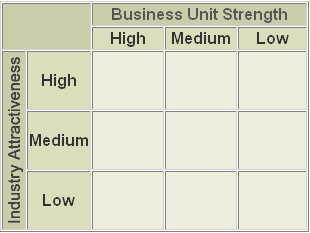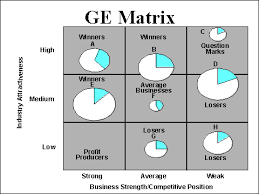GE Mckinsey Matrix
The GE/McKinsey Matrix was developed jointly by McKinsey and General Electric in the early 1970s as a derivation of the BCG Matrix. GE, by that time, had approximately 150 different business units and was disappointed with the profits derived from its investments. This raised internal concerns about the approach the organization had to investment decision making. While exploring new models to implement, GE started to be interested in visual strategic frameworks like the Growth-Share Matrix created by the Boston Consulting Group (BCG) a few years before. However, the BCG Matrix showed to have some limitations. It was considered not flexible enough to include all the broader issues that a company was facing while operating in a fast changing global environment. The GE/McKinsey Matrix solves most of the issues of the BCG model and proposes a more sophisticated and comprehensive approach to investment decision making.





Strength & Weakness

Assessment of Apple business units in the GE/McKinsey Matrix
From an assessment of the above GE/McKinsey Matrix, it becomes clear that Apple is at least moderately strong in each of its business units and it competes in a number of attractive and fast-growing segments, such as tablet computers and smartphones. A competitor performing this analysis would realize that Apple is unlikely to divest any of these business units and is likely using its personal computer and music products as cash cows in order to fund R&D and growth in the faster-growing markets. The barriers to entry in all of these markets are considerable, since entry would require a large amount of funding for either R&D or the acquisition of the necessary technology and expertise. If the company performing this analysis decides to compete with Apple, it should do so in the newest, fastest-growing markets (tablets and smartphones), as these represent the areas of greatest opportunity, despite Apple’s early dominance.
The GE/McKinsey Matrix is a nine-cell (3 by 3) matrix and it is primary used to perform business portfolio analysis on the strategic business units (SBU) of a corporation. A business portfolio is the collection of all the business units within a corporation and a large corporation has normally many SBUs. Each SBU is a distinctive and unique unit that falls under the same strategic hat. A well balanced portfolio is one of the top priorities of a large organization. The strategic business units are the basic blocks that compose a business portfolio. A unit can be a divisions or even a whole company owned by the parent organization.
The nine-box matrix provides decision makers with a systematic and effective framework for a decentralized corporation to make better supported investment decisions and for developing strategies for future product development or new market segment entries. Instead of looking solely at each unit's future prospects, a corporation can adopt a multi-dimensional approach based on two components that will indicate how well the unit will perform in the future. The two components used to evaluate businesses, which also serve as the axes of the matrix, are the 'attractiveness' of the relevant industry and the unit's 'competitive strength' within the same industry. Each axis is then divided into Low, Medium and High.



Six steps are necessary to implement the GE/McKinsey analysis:
- 1. Determine which factors are relevant for the corporation in the industry where it operates
- 2. Assign a weight to each factor
- 3. Score each factor
- 4. Multiply the relative scores and weights
- 5. Sum all up and interpret the graph
- 6. Perform a review / sensitivity analysis
The plotted circles convey the information in the following way:
- The size of the circle represents the market size of the SBU
- The share owned by the SBU is expressed as a pie slice with its relative percentage inside
- The expected future direction of the SBU is represented with an arrow
The circles representing SBUs are then placed within the matrix. As a result, the executives of the corporation will have a clear and powerful analytic map for understanding and managing their entire multi-unit business. The units that fall above the diagonal indicate the investment and growth to be pursued; the units along the diagonal require a thorough analysis and individual selection for investment; finally the units below the diagonal might indicate divestments are necessary or otherwise that businesses can be kept only for cash reasons. The placement of the units within the matrix is a necessary first step before the analysis phase that requires human judgement can begin. For example, a strong unit in a weak industry is in a very different situation than a weak unit in a highly attractive industry.

Strength & Weakness
The GE/McKinsey Matrix, as an extension of the BCG framework, shares the aforementioned advantages of the BCG model. Though the GE/McKinsey Matrix is more sophisticated than the BCG matrix and can provide higher value information for the executive management, it has several flaws and limitations:
- No proven relationship between market attractiveness and business position.
- The relationships between different units are not taken into account.
- The core-competencies that lead to value creation are not taken into consideration.
- The approach requires extensive data gathering.
- Scoring is personal and subjective (risk of bias)
- There is no hard and fast rule on how to weight elements.
- The GE/McKinsey Matrix offers a broad strategy and does not indicate how best to implement it.
For the above limitations and issues, the GE/McKinsey Matrix can serve more as a quick strategic visual framework rather than as a resource allocation tool.
Example of application of GE Mckinsey Matrix
Apple Inc. is a large technology company with several business units operating in different markets, including desktop computers, laptops, tablet computers (iPads), portable music players (iPods), smartphones (iPhones) and software to support these products. A competitor wishing to gain competitive intelligence on the activities of Apple Inc. could do so by placing its business units into a GE/McKinsey Matrix. By analyzing this matrix, it could determine which business units Apple is likely to invest in heavily, develop selectively, or divest.
The market attractiveness axis would be relatively easy for the competitor to assess if it is currently operating in that market, since this consists of factors external to Apple. This includes easily obtainable information such as the current market size and market growth rate. However, some factors would have to be assessed subjectively, such as barriers to entry and the state of technological development.
In contrast, the business unit strength axis would be more difficult to assess since it consists of factors internal to the company, such as customer loyalty, access to resources, and management strength. However, a great deal of information could be obtained from secondary sources, such as the Internet, the media, and shareholder reports.

From an assessment of the above GE/McKinsey Matrix, it becomes clear that Apple is at least moderately strong in each of its business units and it competes in a number of attractive and fast-growing segments, such as tablet computers and smartphones. A competitor performing this analysis would realize that Apple is unlikely to divest any of these business units and is likely using its personal computer and music products as cash cows in order to fund R&D and growth in the faster-growing markets. The barriers to entry in all of these markets are considerable, since entry would require a large amount of funding for either R&D or the acquisition of the necessary technology and expertise. If the company performing this analysis decides to compete with Apple, it should do so in the newest, fastest-growing markets (tablets and smartphones), as these represent the areas of greatest opportunity, despite Apple’s early dominance.
Suranjan Das
ReplyDeleteI am a doctoral student writing my dissertation entitled "A PHENOMENOLOGICAL STUDY OF LEADERSHIP TOOLS FOR ENVIRONMENTAL SUSTAINABILITY". Presently I am preparing my proposal for approval from the IRB.
Within the content I have used your figure "Assessment of Apple business units in the GE/McKinsey Matrix" from your 2011 article "GE Mckinsey Matrix".
Would you grant permission to use this figure in my dissertation? I would be most grateful. I also would like how you would want it cited and referenced in the event this is from a published article.
Sincerely
Barbara Barnes Plourde
1109 Magnolia Street
New Smyrna Beach, FL 32168
(386) 428 6560
I'm glad to be reading this article, I simply want to offer you a huge thumbs up for your great information.
ReplyDeleteTableau Guru
www.sqiar.com
ReplyDeleteAwesome,
Thank you so much for sharing such an awesome blog...
online supermarket in south-b
buy napkins online Eastleigh
very informative and useful stuff.. keep post more
ReplyDeletebuy vegetables online nairobi-b
buy soft drinks online south-b
buy baby products online Eastleigh
buy dairy products online pumwani
ReplyDeleteAwesome,
Thank you so much for sharing such an awesome blog...
buy napkins online eastleigh
Very informative and impressive post you have written, this is quite interesting and i have went through it completely, an upgraded information is shared, keep sharing such valuable information. McKinsey
ReplyDelete